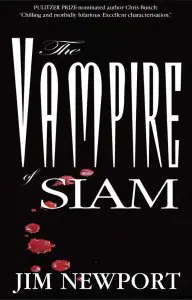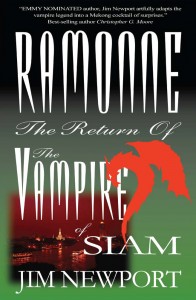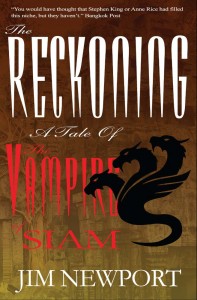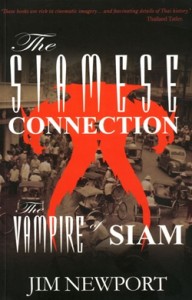 Vampire literature is back in everyone’s focus. As a matter of fact, it seems that bookstores have their bookshelves crammed with vampire adventures, both for young adult readers and the adult readership. This, however, has nothing to do with Jim Newport, who finished his Vampire of Siam trilogy in 2006. Comprised of The Vampire of Siam (2004), Ramonne – The Return of The Vampire of Siam (2005) and The Reckoning – The Tale of the Vampire of Siam (2006), Jim’s trilogy tells the reader the story of Ramonne Delacroix, a 175-year-old French vampire that made Bangkok his home. This year, Jim Newport added a forth novel to the series, The Siamese Connections.
Vampire literature is back in everyone’s focus. As a matter of fact, it seems that bookstores have their bookshelves crammed with vampire adventures, both for young adult readers and the adult readership. This, however, has nothing to do with Jim Newport, who finished his Vampire of Siam trilogy in 2006. Comprised of The Vampire of Siam (2004), Ramonne – The Return of The Vampire of Siam (2005) and The Reckoning – The Tale of the Vampire of Siam (2006), Jim’s trilogy tells the reader the story of Ramonne Delacroix, a 175-year-old French vampire that made Bangkok his home. This year, Jim Newport added a forth novel to the series, The Siamese Connections.
It seems that Jim Newport had three good years in which he published, first at Asia Books, then at Willat Publishing, his vampire books. And, to be honest, Thailand needed these novels to fill in the gap of a niche writing that hasn’t been explored until Jim entered the scene. To my knowledge, there are no other vampire books about / set in Thailand.
In the first book, The Vampire of Siam, we are introduced to Martin Larue, a man wealthy beyond measure who has made Bangkok his home. He likes to attend film festivals all over the globe, tries his hand at cinema journalism, and enjoys the finer things in life. But he is jaded and bored and he desperately needs some excitement. That is until Martin uncovers a serial killer in the City of Angels and his article is front-page news. This leads to a visit from the murderer himself, a sophisticated and worldly vampire called Ramonne. A bond is formed between the two and Martin becomes intoxicated by the vampire’s powers. On the verge of crossing to the dark side himself, Martin is betrayed and plunged into a mortal hell, from which he will ultimately learn a lesson about how precious life really is.
 My favourite of all four books is the second one, Ramonne – The Return of The Vampire of Siam, with its bloody narrative, which weaves throughout the novel on three different paths. First, you have the story of Martin Larue’s return from a year of monkhood and the start of a relationship with Yaya, another character from the first book. Then, you have Kanchana, a rich Thai woman who resurrects Ramonne in search of eternal health and beauty, only to later regret her transformation into a vampire. Third, there’s Mestaphel, the Muslim terrorist, who plans to blow up Bangkok’s red light district. The one that connects these three plots is, of course, Ramonne, who gets a job as a hitman.
My favourite of all four books is the second one, Ramonne – The Return of The Vampire of Siam, with its bloody narrative, which weaves throughout the novel on three different paths. First, you have the story of Martin Larue’s return from a year of monkhood and the start of a relationship with Yaya, another character from the first book. Then, you have Kanchana, a rich Thai woman who resurrects Ramonne in search of eternal health and beauty, only to later regret her transformation into a vampire. Third, there’s Mestaphel, the Muslim terrorist, who plans to blow up Bangkok’s red light district. The one that connects these three plots is, of course, Ramonne, who gets a job as a hitman.
What I find hard to understand is the author’s choice of using the “f” word almost every other page. No doubt that any vampire novel needs its share of sex and violence, but gratuitous foul language only wipes out a whole lot of possible readers. Or, maybe, I’ve been immersed in my own world for so long that I lost track of reality and, actually, Jim’s dialogue is a good mirror of what is being said out there, in the world of Bangkok’s red light districts.
A plethora of other characters, some brought to life only as a means to satisfy Ramonne’s and Kanchana’s appetite for blood, litter the rest of the novel. From bodyguards, blind shamans, prostitutes, crooks, mafia bosses, politicians, drunkard police officers, gangsters, religious fanatics, drivers, and trusted servants, they all form the ingredients of a recipe Jim Newport would like us to believe is part of every day life in Bangkok.
 The Reckoning – The Tale of the Vampire of Siam, book number three in trilogy, takes the reader on a wild trip from Paris to Angkor Wat, to ancient Siam and then to modern-day Bangkok. The readers are made private to Ramonne’s quest for the secrets of his past. Finding his old journal in Paris, Ramonne retraces the fateful journey that he made in 1858 with Henri Mohout to Southeast Asia (an expedition that happened in real life!). Martin Larue is back, this time as the founder of an orphanage and a school in Cambodia, right outside the gates of the ancient temples of Angkor. Here, Martin’s fate is once again entwined with Ramonne’s: the vampire encounters Zhoupeng, a thousand-year old creature whose bite originally transformed him.
The Reckoning – The Tale of the Vampire of Siam, book number three in trilogy, takes the reader on a wild trip from Paris to Angkor Wat, to ancient Siam and then to modern-day Bangkok. The readers are made private to Ramonne’s quest for the secrets of his past. Finding his old journal in Paris, Ramonne retraces the fateful journey that he made in 1858 with Henri Mohout to Southeast Asia (an expedition that happened in real life!). Martin Larue is back, this time as the founder of an orphanage and a school in Cambodia, right outside the gates of the ancient temples of Angkor. Here, Martin’s fate is once again entwined with Ramonne’s: the vampire encounters Zhoupeng, a thousand-year old creature whose bite originally transformed him.
The fourth and last book (at least, for now!) in the Vampire of Siam series is The Siamese Connections. The novel begins in Bangkok in 1948, shortly after the end of World War II and the Japanese occupation. Ramonne becomes involved in a quest for the Oracle, a mysterious, supernatural artifact that was hidden during the war by the Japanese. He joins forces with American expat Jim Thompson (who, rumors have it, before he became the “Silk King,” was an OSS agent) and together they wage war against the Black Dragons. The tale picks up where the third book left off. Of course, Martin Larue and his pregnant wife cross paths with the vampire, and soon they too are involved in a deadly game of cat and mouse with the Japanese, who are also in search of the Oracle.
 Jim Neport’s style of writing is typical to someone who has been in the movie industry for a long time: brief and concise. The author, a production designer for both film and television (Jim worked with Nicholas Cage in the 2008 Bangkok Dangerous), leaves the impression that his books are actually extended movie scripts. The novels are dialogue-driven, with very little emphasis on descriptions and characterization. Bottom line, the Vampire of Siam is an action-packed series that reads easily and makes a good companion on a trip to the beach.
Jim Neport’s style of writing is typical to someone who has been in the movie industry for a long time: brief and concise. The author, a production designer for both film and television (Jim worked with Nicholas Cage in the 2008 Bangkok Dangerous), leaves the impression that his books are actually extended movie scripts. The novels are dialogue-driven, with very little emphasis on descriptions and characterization. Bottom line, the Vampire of Siam is an action-packed series that reads easily and makes a good companion on a trip to the beach.
All four books are actually stand-alone novels, but I recommend reading the quadrilogy in its chronological order. Still, Jim Newport inserts enough background information in all his vampire books so that the reader is not left with unanswered questions regarding the relationship between the vampire and Martin Larue, Ramonne’s old “friend”.
Jim Newport has been living in Thailand for 15 years, with frequent flights to Los Angeles. From his base in Phuket, he has also published two other books about Hollywood and Jimi Hendrix: Tinsel Town and Chasing Jimi. For more info on these novels, visit his website.
Originally published in “Bangkok Trader” (Vol.5, No.11, October 2011)

